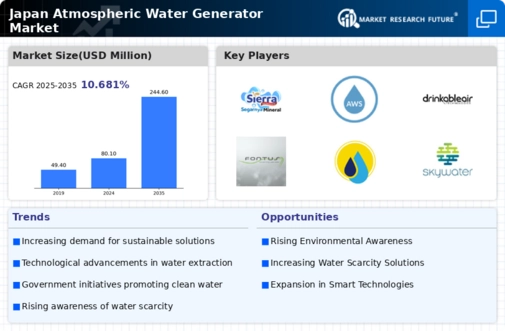The atmospheric water-generator market in Japan is characterized by a dynamic competitive landscape, driven by increasing demand for sustainable water solutions amid growing environmental concerns. Key players such as Watergen (IL), Skywater (US), and Zero Mass Water (US) are at the forefront, each adopting distinct strategies to enhance their market presence. Watergen (IL) focuses on innovation, particularly in developing advanced atmospheric water generation technologies that cater to both residential and commercial sectors. Meanwhile, Skywater (US) emphasizes regional expansion, targeting areas with acute water scarcity, thereby positioning itself as a critical player in emergency water supply solutions. Zero Mass Water (US) leverages partnerships with local governments and NGOs to promote its solar-powered water generation systems, aligning its operations with sustainability goals and community needs.
The business tactics employed by these companies reflect a concerted effort to optimize supply chains and localize manufacturing processes. The market structure appears moderately fragmented, with several players vying for market share while also collaborating on initiatives that enhance technological capabilities. This collective influence of key players fosters a competitive environment where innovation and sustainability are paramount, shaping the overall market dynamics.
In August 2025, Watergen (IL) announced a strategic partnership with a leading Japanese technology firm to co-develop next-generation atmospheric water generators tailored for urban environments. This collaboration is likely to enhance Watergen's technological edge and facilitate entry into densely populated areas, where water scarcity is increasingly pressing. The partnership underscores the importance of local expertise in navigating regulatory landscapes and consumer preferences in Japan.
In September 2025, Skywater (US) launched a new model of its atmospheric water generator, designed specifically for disaster relief applications. This model incorporates advanced filtration systems and is capable of producing up to 1,500 L of potable water daily. The introduction of this product not only strengthens Skywater's position in the emergency response market but also highlights the growing trend of integrating advanced technology into water generation solutions, catering to urgent humanitarian needs.
In October 2025, Zero Mass Water (US) expanded its operations by securing a contract with a major Japanese municipality to install its solar-powered water generation systems in public spaces. This initiative is indicative of a broader trend towards public-private partnerships aimed at enhancing water accessibility. By aligning its offerings with governmental sustainability initiatives, Zero Mass Water is likely to solidify its market position while contributing to community resilience against water scarcity.
As of November 2025, the competitive trends in the atmospheric water-generator market are increasingly defined by digitalization, sustainability, and the integration of artificial intelligence in operational processes. Strategic alliances are becoming more prevalent, as companies recognize the value of collaboration in enhancing technological capabilities and market reach. Looking ahead, competitive differentiation is expected to evolve, shifting from traditional price-based competition to a focus on innovation, technological advancements, and supply chain reliability. This transition may ultimately redefine the competitive landscape, fostering a more sustainable and resilient water generation ecosystem.





















Leave a Comment